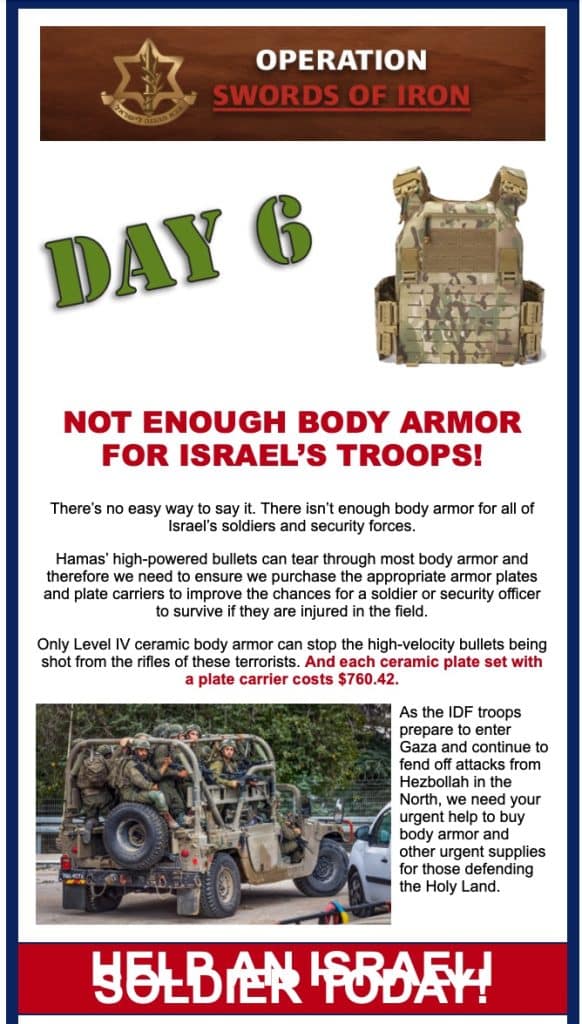
It is one thing to drop bombs or artillery on a population without air defense or counter-battery units. It is an entirely different animal to put troops on the ground to engage entrenched forces. Just ask the Ukrainians. Based on the image above, if true, which showed up in my spam today with a plea to kick in some cash so Israeli soldiers can buy body armor, it appears the Israeli Army is not ready for prime time.
When you advertise yourself as the greatest military power in the Middle East, this is not a good look. What has Israel been doing with all the U.S. financial assistance sent to bolster its defense? I initially was inclined to believe that this was just some opportunistic grift. But then I saw the report, published last Monday, in the Times of Israel. It appears the shortage is genuine.
Reserve soldiers from all over the country complained on social media Sunday that they were not properly equipped by the military for anticipated large-scale operations, with many seeking to privately purchase the required gear. . . .
But as reservists began reporting to their units near Gaza, in the West Bank, and at the northern border, complaints started coming in about a lack of equipment, with many fighters focusing on the need for ceramic plates for their protective vests. The plates help to prevent projectiles such as bullets from penetrating the vest.
Israel’s problem may be something more serious than an equipment shortage. According to Sy Hersh, the Israeli Army, which is comprised predominantly of reservists, is not ready for urban combat:
The major issue for the Israeli war planners is a reluctance, despite the mobilization of more than 300,000 reservists, to engage in a door-to-door street battle with Hamas in Gaza City. One veteran of the IDF, who served in a high post, told me that half of the Israeli Army has been engaged for the past decade or more in the protection of the increasing number of small settlements scattered in the West Bank where they are bitterly resented by the Palestinian population. “The Israeli planners don’t trust their infantry,” the insider said, nor their willingness to go to war but what could be a disastrous lack of combat experience.
While the Israeli Air Force is turning northern Gaza into a moonscape, this does not guarantee that Hamas bunkers and tunnels have been eliminated. German soldiers who entered Stalingrad after the Luftwaffe leveled most of that city in August of 1942, found themselves unable to move freely because of the massive piles of rubble that blocked the streets and avenues of Stalingrad. The mountains of broken concrete not only hindered the ability of German tanks to maneuver, it also provided cover and concealment for Soviet soldiers who then counter attacked the German columns. The Soviets suffered more than a million casualties in that battle, but defeated the Army of General Von Paulus. This is what has Israel’s Generals worried.
I am not suggesting that Hamas has the command, control and training commensurate with what the Soviets employed at Stalingrad. But, given their ability to pull off the cross-border invasion a week ago Saturday, it would be foolish to assume that Hamas has not planned for this type of contingency. It is highly likely that Israel will be able to advance into the northern portion of the Gaza Strip, but at what cost?
While the Israeli public are united in their outrage over the Hamas attack and the failure of the Israeli Defense Force to safeguard the border separating Gaza from the Israelis settlements, there are deep political fissures, actually a chasm, separating the Jews with roots in Europe from those who came from North Africa and the Middle East. It is sort of like the divide in the United States between the Black Lives Matter crowd and the Freedom Caucus. They don’t have a lot to talk about with each other. If, or when, the Israeli Army starts to incur massive casualties, the political support Netanyahu currently enjoys will evaporate like water in the desert.
It appears that Israel has not provided adequate training on urban combat operations to its reserve cadre. That is a problem with no short-term solution. You can train soldiers to carry out that mission, but that would mean a minimum of two months of intense instruction.
We should know in the next few days if Israel is ready to make good on its vow to wipe out Hamas on the ground with its Army or, as Sy Hersh reports, will engage in a massive bombing campaign and hope that tactic finishes Hamas.
One of the major wild cards not yet played is what the rest of the Arab and Muslim world will do. The images of dead Palestinian children and women are flooding social media in those communities and fueling calls for revenge. If that anger reaches a breaking point, Israel could find itself fighting more than just Hamas.
The post Is Israel Ready To Fight Hamas? appeared first on The Gateway Pundit.